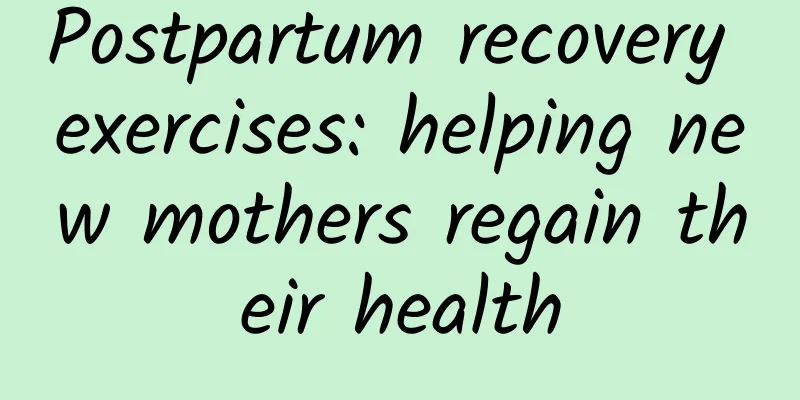Postpartum recovery exercises: helping new mothers regain their health

|
The process of pregnancy is "painful" and happy. With the birth of the baby, the pregnant mother's uterus and pelvic floor will also be damaged accordingly. Now more and more postpartum mothers have pelvic floor dysfunction, postpartum urinary incontinence, low back pain and other phenomena, which seriously affect the health and quality of life of new mothers. Paying attention to women's health and saving pelvic floor function are our focus. Postpartum rehabilitation exercises are one of the important ways to help new mothers restore their health. So what does postpartum rehabilitation exercises include? Suitable postpartum rehabilitation exercise options: 1. Postpartum walking Postpartum walking is a simple, easy and effective method of postpartum rehabilitation exercise. New mothers can choose to walk outdoors or indoors, making sure the road is flat and free of obstacles. In the initial stage, they can walk for 10-15 minutes and then gradually increase to more than 30 minutes. 2. Postpartum Yoga Postpartum yoga can help new mothers restore their health, strengthen their core muscles and pelvic floor muscles, and improve flexibility and stability. Postpartum yoga should start with gentle stretching exercises, such as: Butterfly Pose (sitting on the ground, put the soles of your feet together and then slowly bend down), Downward Dog Pose (palms and feet on the ground, hips lifted up), etc. When doing yoga exercises, pay attention to correct posture, maintain body symmetry and balance, do not exert excessive force or stretch, breathe naturally and steadily, and do not hold your breath to avoid overwork. 3. Pelvic floor muscle training During childbirth, the pelvic floor muscles may be stretched or torn, affecting the function of the muscles. Through pelvic floor muscle training, new mothers can restore the strength and function of the pelvic floor muscles and improve the occurrence of problems such as urinary incontinence. One exercise may not bring significant results. It is recommended to perform multiple training sessions every day, each session lasting about 10-15 minutes, and then gradually increase the intensity and frequency according to personal circumstances. 4. High-intensity interval training For new mothers who have passed the postpartum adaptation period, they can consider high-intensity interval training, which can help mothers burn fat, enhance cardiopulmonary function and muscle strength. Here are some specific exercises suitable for postpartum recovery: 1. Pelvic floor muscle contraction: Sit in a chair, relax your body, and place your feet flat on the ground; Slowly contract your pelvic floor muscles and gradually increase the strength of the contraction. Keep the contraction for 5 seconds, then slowly release the muscle; Repeat 10 times, 2-3 times a day. 2. Abdominal Crunches: Lie flat on your back on a yoga mat with your legs bent and your feet flat on the ground. Lift your head and upper back, using your arms to gently support your head; Slowly tighten your abdominal muscles and lift your upper back, lifting your shoulders off the ground; Slowly lower your body and repeat 10-15 times; 3. Bridge pose: Lie flat on your yoga mat with your legs bent, feet flat on the ground, and arms at your sides. Slowly tighten your abdominal muscles and push your hips up so that your body forms a straight line; Hold the position, count to 5, then lower your hips, and repeat 10-15 times; 4. Brisk walking or jogging: Wear appropriate sports shoes and choose a treadmill or flat road; Start by walking, then gradually increase your speed and pace to brisk walking or jogging; Control your breathing, maintain correct posture, pay attention to your body's signals, and choose the appropriate intensity and time based on your own feelings. If the postpartum rehabilitation training movements are not standard, it may slow down the body's recovery time. This kind of rehabilitation training is ineffective, so it should be conducted under the guidance of a professional. Rehabilitation training is very important and can promote the recovery of pelvic floor muscles and abdominal muscles, and relieve certain symptoms caused during pregnancy, such as vaginal relaxation, urinary incontinence, etc. When doing postpartum rehabilitation exercises, new mothers need to pay attention to the following: 1. Start exercising under the guidance of a doctor or professional postpartum rehabilitation staff Before starting postpartum rehabilitation exercises, new mothers should consult a doctor or professional, assess their physical condition, and develop an exercise plan that suits them based on their personal circumstances. 2. Start exercising gently In the early postpartum period, new mothers should choose gentle exercise, such as walking, gentle yoga or pelvic floor muscle training, and gradually increase the frequency and duration of exercise to avoid excessive fatigue or injury. 3. Pay attention to your body’s signals During exercise, new mothers should pay attention to the signals sent by the body. If they feel pain, discomfort or excessive fatigue, they should stop exercising and rest. Do not force yourself to complete overly difficult movements. You can do moderate exercise 3 to 5 times a week and gradually increase the intensity and duration of exercise. 4. Dress comfortably Choose comfortable and breathable sportswear to ensure comfort during exercise. Postpartum rehabilitation exercise is essential for new mothers to recover their health. Choosing appropriate exercise methods, following safety precautions, and exercising under the guidance of professionals can help new mothers recover their health faster, increase muscle strength, improve cardiopulmonary function, and relieve postpartum depression. The above opinions are only personal opinions. Please note that the recovery process of each new mother is different, so please adjust according to your own situation and choose appropriate exercise to practice. (Liu Lijie, Nursing Department, Shijiazhuang Maternal and Child Health Hospital) |
<<: Can't help but step on the "empty pedal"? No kidding! Shaking your legs is really a good habit!
>>: Mental health during pregnancy: How to reduce anxiety and stress
Recommend
What is the cause of frequent fetal movements at 19 weeks?
Fetal movement is very normal. Women will experie...
Early picture of female athlete's foot
Athlete's foot is a very common disease. In f...
What should I pay attention to after taking birth control pills?
Birth control pills are oral contraceptives, whic...
Will the cervical cyst disappear on its own?
In daily life, many women are always troubled by ...
Women should be lustful. 6 colors of food will make you healthier the more you eat.
Women are colorful. Dressing in different colors ...
Bleeding again after menstruation
Normal menstruation should be about 14 days after...
Large blood clots during menstruation
The menstrual period is a special period for wome...
Immunohistochemistry results
Immunohistochemistry is a detection method that i...
What is cervical gland cyst? Is it serious?
Cervical glandular cyst is also called cervical N...
The most effective gynecological hemostatic drug
Among gynecological diseases, we can easily find ...
What to do if a girl's breasts sag
What should a girl do if her breasts are sagging?...
Which blood type is more likely to get serious illness? A batch of research answers are here!
There are many discussions about blood types, esp...
Fall Sports Notes
As autumn approaches, are you still exercising ev...
Please know this about monkeypox!
Recently, Beijing and Guangzhou have successively...
Side effects of ornidazole vaginal suppositories
We know that the female reproductive organs are v...









